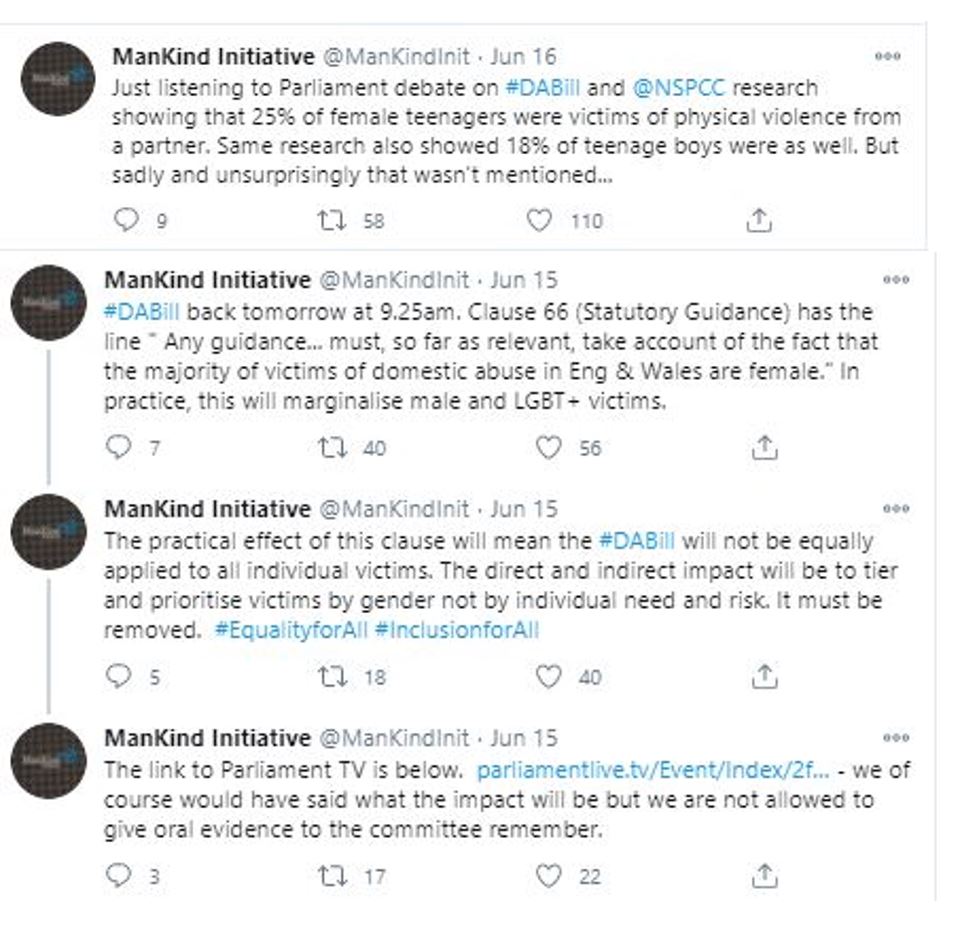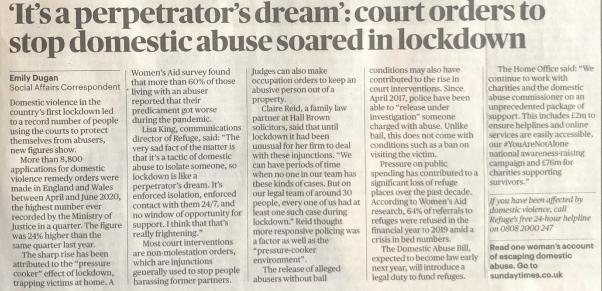
While every reasonable person would wish to ensure domestic abuse victims are fully supported, this Sunday Times article makes a number of claims that follow a recent narrative which doesn’t appear to be completely honest. In my view, without total transparency, integrity and honesty about domestic abuse, and, indeed, in the wider field of Family Law and Justice, poor policies will be implemented and poor decisions made.
Specifically, on the topic of domestic abuse, the public debate has sadly become very polarised between female and male perspectives. Indeed, it could be argued that articles, such as this one in the Sunday Times, are not only misleading but opportunistically aimed at increasing pressure on government to provide funding for women's domestic abuse charities on the basis of possible exaggeration. So, we need take a granular look at what the data is telling us, rather than seizing on top-line figures for the sake of sensational headlines.
This article's opening sentence states: “Domestic violence in the county’s first lockdown led to a record number of people using the courts to protect themselves from abusers’ new figures show.” It goes on to say “More than 8,800 applications for domestic violence remedy orders were made between April and June 2020, the highest number ever recorded by the Ministry of Justice in a quarter. The figure was 24% higher than the same quarter last year.”
These are big claims, which the author attributes to “the pressure cooker effect of lockdown”, a familiar line repeated countless times in the media and in postings from women's charities, such as Women’s Aid and Refuge. Personally, I have a very different view, so I will get that on the table now, because my view leaves me suspicious of these claims, sufficient enough to want to “take a look under the hood” so to speak. It’s my view, that in lockdown, whilst in some households it will be more tense, many of the pressures of daily life were removed, for example:
1. Most people’s working situations were one of the following
a. Going to work as normal but fewer people there (except for emergency services)
b. Working from home and managing child care/home schooling intermittently
c. Not going to work at all but still being paid either full salary or 80% of (up to the maximum allowable of course – which covers most households), but with far fewer outgoings because there was nothing to do and nowhere to go, except watch tv and buy pointless stuff from amazon.
2. Most children had BOTH parents at home with them for lockdown! That’s right, 2 parents to look after the kids ALL the time and share the housework, food shopping and preparation, and no pressure from work to hit a deadline, no getting stuck in traffic and no chance of one of the parents cheating on the other with someone at work or from the pub, no staying out late with mates or being late for a school run.
3. Some families will have had older siblings to help out, or even grandparents that may have been living with them.
4. People weren’t going out and getting drunk, sure some would just do that at home on supermarket booze, a study by the charity Alcohol Change[1] found that a third of regular drinkers cut their consumption during lockdown, 6% didn’t drink at all, nearly half was roughly the same and 21% said there consumption had increased…but as a net impact, alcohol consumption fell during lockdown. Dr Adam Winstock (UCL Epidemiology & Health) is quoted[2] as saying “whilst use of some types of recreational drug may see an initial spike under lockdown, their use is likely to diminish due to the lack of opportunities to socialise”. Alcohol & drug consumption are very often major factors in domestic abuse, a Swedish study report by the BBC earlier this year, highlighted that drug and alcohol consumption led to a 6 x raised risk of domestic violence[3]although for some reason the study only attributes this rise to males, when alcohol and drugs have the same effects on males and females.
5. There were no loud parties next door, and there was community spirit, like we hadn’t seen in a long time with NHS clapping each Thursday etc.
6. The weather was amazing, most of the time, from pretty much the day lockdown started, people were even saying it was the worlds way of saying thank you for giving it a rest, and a chance to recover from the extraordinary burden of pollution that we place on it.
So, it was all these reasons, which led to a raised eyebrow when I saw, seemingly never-ending claims, that men were beating their wives/partners and children up, just because they could and just because those wives/partners and children couldn’t escape.
With that, let us delve into the data so that we can fact check.
Claim 1 - 8,800 applications were made April to June 2020
This is actually slightly understated. There were 8,899 applications.
Claim 2 – 24% higher than the same quarter last year
This is correct, albeit that Non-Molestation Orders (NMOs) increased by 26% while applications for Occupation Orders increased by 17%. However, this is not the full picture. NMO’s actually granted were up 18%, while Occupation Orders actually granted were down 3.6%.
Claim 3 – from the title of the article “domestic abuse soared in lockdown”
This is where the rhetoric begins to crumble. Although there was an apparent increase in claims, the clear insinuation was that this increase was “due to lockdown”, and that it “soared”. So, this is where we need to get into the detail to determine whether or not these claims are valid. Getting into the detail means dissecting the data on a number of levels, as follows:
1. The graph below shows the steady increase we’ve seen in applications for Non-Molestation Orders since 2011. There is a clear upward trend ever since 2013, that simply continues into and beyond lockdown at a similar pace, so can this be attributed to lockdown, or is it the case that the family law industry simply continues it seemingly relentless ‘business as usual’ growth march?
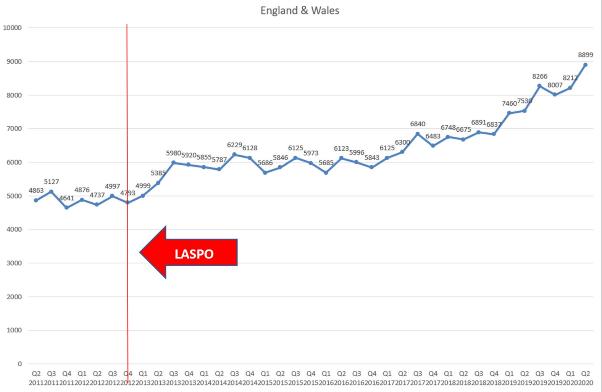
2. Sticking with the graph above, LASPO (Legal Aid, Sentencing and Punishment Act 2012) was brought into law as an austerity measure, with the intention of reducing the burden of a significant legal aid bill. The bill was not without controversy or warning from the legal profession that it will lead to a rise in false allegations being made in order to gain legal representation with the bill paid by the state. You can see clearly, that there is a consistent and static level of NMO applications leading up to the bill becoming law, followed by a steady climb resulting in almost double the quantity in the space of 7 years. Over the course of that time, the barrier for successful application to legal aid has been lowered, steadily, such that it is now sufficient to have a letter from a GP or domestic abuse charity stating there is domestic abuse, in order to meet the requirements. With these letters, a Non-Molestation order will be granted in over 95% of cases, with no review of evidence required, just a verbal say so of the applicant. From this point forward, the applicant is entitled to legal aid, and their solicitor can stretch out their case as long as is necessary at the tax payers’ expense, and not only will that legal aid cover this protection order, but all matters relating to divorce and child arrangements. During lockdown, of course, GP appointments were by telephone, and the same would be true for domestic abuse charity assistance, therefore a telephone call was all that was required to gain the “evidence” required to meet the legal aid threshold, not that prior to lockdown it was in any way difficult to meet the threshold, as no due diligence is carried out to determine whether claims have any foundation, professionals are instructed to “believe the victim” (but only if they are female), both Women’s Aid and Refuge make this clear in their marketing, see below.
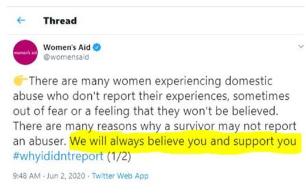
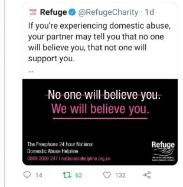
A video produced by The Glass Blind Spot[4], investigates the National Domestic Abuse Helpline, operated by Refuge to compare the responses to male and female victims of abuse. The difference is nothing short of shocking, and clearly in breach of Equality laws, discriminating against men and favouring women on the grounds of sex. Worse, male callers to Respect, a charity whose purpose is to support male victims of domestic abuse, takes callers to their service through a 22 point triage questionnaire, 17 of those questions are to vet whether they are in fact a perpetrator of domestic abuse claiming to be a victim, subsequent to which they may report that caller to social services and disclose the details to their female abuser! It is little wonder, that male victims of abuse are so reluctant to reach out for support, and therefore 3 x less likely to report than a female victim of domestic abuse.
3. Next, I think it is important to look at what possible geographic influences there are with these applications, because surely, if “lockdown” was responsible for “soaring” incidents of domestic abuse, then this would be reflected pretty much uniformly around the country?! But we aren’t seeing uniformity at all, first of all let’s take a look at how the numbers breakdown across England & Wales.
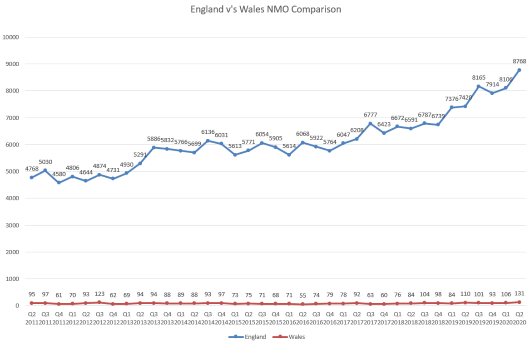
The first thing anyone would notice from the chart above is that Wales has remained static over the entire timeline of the chart, whilst there is substantial growth in England. How can that be? Is it that domestic abuse is only on the rise in England? So, we must dig a little deeper now to find out what other anomalies may be at play…but this certainly shows lockdown has had no effect whatsoever so far as domestic abuse prevalence is concerned in Wales, which is great news! Note to self to let Welsh Women’s Aid know about this immediately!
4. Digging further means we look at the regions of England, because surely if its true that domestic abuse “soared” during lockdown, that would be pretty much uniform across the nation of England too, and broadly in line with the whole of England chart? The chart below says, no, that isn’t the case! In fact, you can see very clearly that the bulk of the increase comes from the South East and Midlands regions (65% of the total increase since 2011), with London seeing no growth at all in applications since 2011, and other regions much more modest rises.
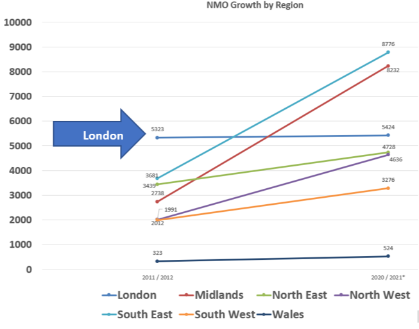
Its immediately apparent from this graph, that London, the most densely populated area of the country, somehow has seen a 7% reduction in the requirement for protective court orders during lockdown compared to the previous quarter, and the Q2 figure in 2020 was 1.3% lower than the same period in 2019! Contrast this oddity, with the Midlands region more than trebling since 2011 and the South East region multiplying by approx. 2.5 times. How is this legitimately feasible if there is not widespread manipulation of the system at play?
5. Having seen this rather strange anomaly, its only right that we pursue this thread by comparing directly Q2 from 2019 to 2020, and we see the North East, London and Wales have all declined, while the other regions have increased, how can that be explained?
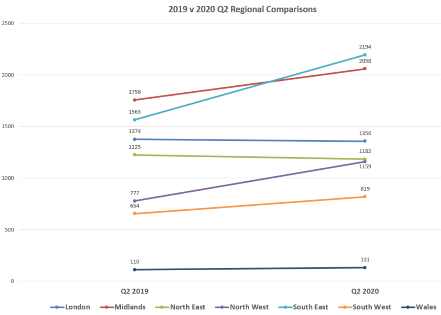
But what is the growth in Midlands and the South East from Q2 2019 to Q2 this year, because that seems to be where the majority of the additional harm is being caused, and either services need to be deployed primarily to those locations, or there is some other dynamic at play?! The total growth in those two regions is 933 applications, from a total increase across England & Wales of 1,440. Taking those two regions away, the nationwide increase in NMO’s would have been 507 or 6.5%, which is much closer to the increase noted in the August police statistical reports. Something smells fishy!
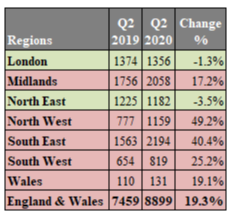
Interestingly, very early on in lockdown we had numerous news stories about resident parents taking advantage of the lockdown to prevent contact between the children and the non-resident parent, example from the BBC below, led to MoJ issuing guidance and Boris Johnson & Co making it crystal clear during Coronavirus press briefings that children should continue to be cared for as per court ordered arrangements. Note the highlighted claim that family lawyers told the BBC they have been “inundated”.

6. It is pretty tricky to quantify how closely related the increase in NMO applications are to the restriction of contact, not least because applications are spread out over such a wide area and over so many courts, but let’s pick a few areas to see what we find. Firstly, let’s look at London, which the data tells us had a slight fall in applications to the court for domestic violence protection orders during the first lockdown, despite being the most densely populated area. When a parent breaches court ordered contact arrangements, the other parent is able to submit a C79 application to enforce the order of the court (at least that is what is supposed to happen, though in practice it happens barely 0.5% of the time). Applications for this type of order rose by a fairly modest 4.6% compared to the quarter immediately before lockdown and by 6% compared to the same quarter the previous year, in line with the general growth in this type of application nationally over the last 10 years. Now if we compare that to Avon & Somerset, the graph below shows us a continued rapid increase in NMO applications from Q1 to Q2, with a total increase in applications of 25 (221 up to 246).
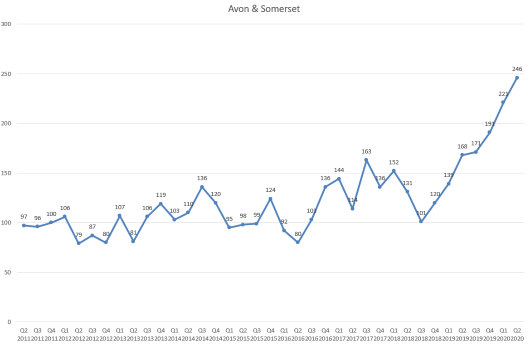
Both Taunton & Bristol courts fall within the Avon & Somerset region and combined they have an increase in C79 Enforcement applications, from Q1 to Q2, of 34, rising from 39 to 73. This begs the question as to how many of those NMO applications were submitted for “tactical” reasons, or maybe this is just a one off? But if we look at Sheffield family court, there was no increase in NMO applications between Q1 & Q2 and there were no applications for C79 Enforcement, in York Family Court, NMO applications dropped by 1 from 38 to 37 and there was a reduction in C79 applications also from the previous quarter of 20 to 15, In Brighton there was an increase of 14 NMO applications, and an increase of 16 C79 applications! I’m seeing a pattern, are you?
7. It could be stated that the above are all mere coincidence, so let’s add some further weight. Figures released by the Welsh Governments VAWG (Violence Against Women & Girls) helpline show a 14% reduction in demand for the period in lockdown compared to the same period the previous year. (note: they use tax year quarters hence why it says Q1 on the chart).
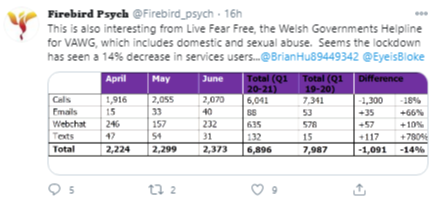
8. Another example of easily accessible data that both sheds light on the actual state of play of domestic abuse through lockdown, and simply must challenge the narrative we’ve been subjected to, is provided though Citizens Advice publicly available data tool[5]. The chart below represents a large sample size of data for this year so far and compares year on year to the previous 12 months. What is very clearly apparent is the substantial increase in domestic abuse enquiries relating to “other family members”, 44% up from the previous year, yet looking at partner abuse by a male against a female there’s a reduction of 12%, a female against a male is down 16% and against a child is also down 12%. The likelihood that Women’s Aid or Refuge have segmented domestic abuse reporting to understand the source of the abuse is slim at best (or they have but choose to keep quiet about the outcome as it not helpful to the narrative), and the police have certainly not disclosed any more granular detail than there being an increase in call outs. It does however stand to reason, that domestic abuse between family members that are not couples may increase, such as between siblings/step siblings, thrown into spending far more time with one another than they ever have and with far fewer outlets for their energy.
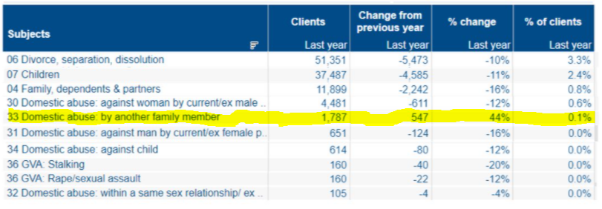
9. Throughout lockdown and beyond, Women’s Aid and Refuge have made claims that demand for their helpline and website has increase by anything from 25% to a 10-fold increase, and various figures in between, with regular reports of this in the media. They’ve recently just announced figures from their webchat service, shown below:
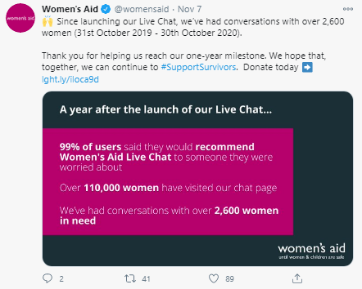
Worthy of note, is that its claimed 110k women visited their chat page (although I’m unsure how it’s possible to determine the sex of anyone browsing a website) and those visits led to conversations with 2,600 women, a conversion rate of less than 2.5%, and less than 10 conversations per day. This seems very modest demand for the service on the face of it, and if the 10-fold increase in demand during lockdown were anything close to being true, suggests they were only having 2 or 3 conversations per day by webchat before and since lockdown!
I have called a number of times for Women’s Aid and Refuge to publish google analytics visitor stats for their website, and a call report provided by the host of the National Domestic Abuse Helpline freephone number, in order that the claims of increased demand can be verified, but those requests have been ignored. Undeterred, on 31st October 2020, I submitted a Freedom of Information Request to the Ministry of Justice, asking them to disclose evidence submitted to them by the top 5 charities (ranked in order of value of funding) that applied to them for a share of the £100m in public funding that was made available by government to the sector as a result of lobbying of parliament early on in the first lockdown. Naturally, one would expect that evidence of demand would be required to have been submitted as part of the application process, as a very modest and reasonable due diligence exercise, before handing over 10’s of millions in tax payer cash. However, after waiting a whole month to come back to me, the response was “I am writing to inform you that we are required to conduct a public interest test in relation to your request. This test is being carried out because some of the information you have requested is covered by section 43(2) of the FOIA. As yet, we have not reached a decision but are aiming to provide you with a full response by 18th December 2020.” I have highlighted the word “some” because I went back to them asking that they release the information which is not covered by “some” without further delay, so far there has been no response. The exemption to which they refer, you will be alarmed to discover, is
![]()

Quite clearly, this is an organisation that does NOT want the public to know whether they asked for any evidence or carried out any due diligence at all, and if they did either of these, they certainly don’t want the public to see what evidence was provided, and the extent of the due diligence that was carried out, that much cannot really be argued. But how tax payer funding, provided to charities purporting to provide an essential service to victims of “soaring” domestic violence during lockdown, could either be considered a not in the public interest or prejudicial to commercial interests is beyond me. This will however, certainly give readers a clear insight into the extent to which the MoJ are prepared to go in order to keep this domestic abuse narrative going, and logically, that can only be because it is commercially beneficial for them to do so!
10. The claims that Ms Dugan, Women’s Aid, Refuge, numerous feminist MP’s and the media generally have been making about the “soaring” levels of domestic abuse don’t tally with police figures, which in May showed an increase of 4% and in August it was 7%, and study carried out by the Institute for Fiscal Studies[6] into Met Police crime data during lockdown, identified only a “modest increase” in reports.
A separate study by the London School of Economics[7], produced the very curious graph below, showing that calls from actual victims are lower than 2019, and all of the increase is attributable to calls from 3rd parties. I find that as odd as it is striking, and it certainly warrants further scrutiny, firstly into whether those calls were relative to partner or child abuse or other forms of domestic abuse that is consistent with the Citizens Advice data.
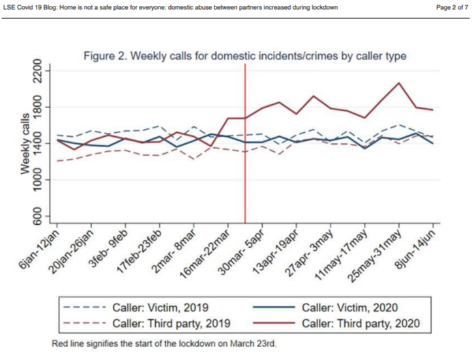
Now don’t get me wrong, any increase in domestic violence or abuse is bad news, support services need to be ready and able to meet the additional demand. But if we step back from this for a moment, and ponder as to whether these figures could legitimately be considered an increase of such dramatic proportions to have warranted the level of lobbying, media attention or government response in terms of money thrown at the ‘alleged’ problem. I say alleged, because of the issues I raised with respect to the increase in non-resident parents having contact with their children severed by the other parent, and the seemingly close association with increase in enforcement applications & the increase in NMO applications, perhaps for tactical purposes, together with the Citizens Advice data showing a substantial drop in partner abuse combined with a substantial increase in abuse between other family members, to which no narrative or attention has been applied whatsoever, and that is before we consider possible partner abuse between same sex couples, with same sex female couples known to have the highest (percentage wise) prevalence of domestic violence.
It is strategically typical for police reports to be filed by those wishing to game the system, which is why it is so important to not simply look at the top line data and consider it a ‘god given’ reflection of the truth, not least because doing so can lead to bad decision making that can have severe knock-on consequences, and it really hasn’t taken a great deal of investigation to see that in this case, the assumption of truth that has been applied, is rested on very shaky foundations!
Claim 4 – “The release of alleged abusers without bail conditions may also have contributed to the rise in court interventions”
Now here’s the thing about this nonchalantly slipped in sentence, as if it’s of not really very much importance, when in fact it is rather critical to understand what impact this had on the overall figure, that Ms Dugan then uses to justify that domestic abuse generally around the nation has soared during lockdown. Articles like this instil a sense of fear into the public, this together with the publicity pumped out by Women’s Aid and Refuge, in my opinion, crosses the line from being a support service, to a “victim procurement” enterprise. Certainly, the financial rewards that are at stake for convincing government to pump eye watering sums of money into the sector are in plain sight. It is none the less shocking that, not a penny of the increased government funding has gone to any of the charities helping male victims of abuse, many of whom will have been falsely accused and often made homeless, as the occupation order statistics show, and without any due diligence being required to inflict dramatically life impacting living circumstances.
Link to Domestic Abuse Bill & Family Court Risk of Harms Review
When reading this article, and the many others like it published this year, I see a PR & Marketing engine at work, to further a dishonest agenda that has deeply impacted proposed legislation in the form of The Domestic Abuse Bill and also in terms of the way the ‘Assessing Risk of Harm to Children and Parents in Private Law Children Cases’ review panel was assembled, then reached its very concerning and potentially catastrophic conclusions for children.
Looking first at the Domestic Abuse Bill, there are many things to be happy about within this bill, every right minded person wants society to be providing support and protection to those impacted by domestic abuse, but there are some aspects of this bill which threaten the delivery of justice, due process, and also undermine the right to a fair trial, which has a severely negative impact to an already disastrous family justice system. The key issue is the slant to all women are victims and all men are perpetrators of abuse, underpinned by The Duluth Model (DM).
The Domestic Abuse Intervention Project was the first multi-disciplinary program designed to address the issue of domestic violence. This experimental program, conducted in Duluth (USA) in 1981, coordinated the actions of a variety of agencies dealing with domestic conflict. A 2011 review of the effectiveness of batterers intervention programs (BIP)[8] (primarily Duluth Model) found that "there is no solid empirical evidence for either the effectiveness or relative superiority of any of the current group interventions," and that "the more rigorous the methodology of evaluation studies, the less encouraging their findings." That is, as BIPs in general, and Duluth Model programs in particular are subject to increasingly rigorous review, their success rate approaches zero.
In spite of the above, The Duluth model is still widely used in the UK for male perpetrators. It reiterates a falsehood that all male aggression is done merely for “power, control, and because he can”. Yet the co-author of this model, Ellen Pence, debunked her own theory when she said: “Somewhere we shifted from understanding violence as rooted in a sense of entitlement to rooted in a desire for power. We created a conceptual framework that did not fit the lived experience of the men and women we were working with. We engaged in ideological practices and claimed them to be neutral observations”
Duluth hinges on the “Power & Control Wheel, shown below. Now, for anyone who has experienced a controlling relationship, whether female or male and not even necessarily an intimate one, but perhaps even in a friendship, a sibling or other family relationship or even a parent child type relationship, they will likely be able to relate a number of the segments in the wheel. However, the entire premise of the wheel is that it relates only to male abuse of females, and by default females will always be the victim of the male aggression and/or oppression.
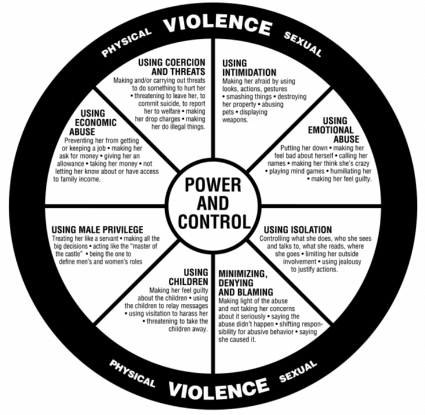
In contrast to the Duluth Model, the National Intimate Partner and Sexual Violence Survey 2010 Summary Report[9] from the Center for Disease Control (CDC) in the USA, gave a breakdown in the frequency of “gendered” violence in their survey. This CDC report showed that whilst it is males that commit more serious violent assaults, it was found that females use psychological abuse and coercive control to a greater extent than men.
In January 1999, Ellen Pence published a book titled “Coordinating Community Responses to Domestic Violence – Lessons from Duluth and Beyond”, in which she says “The DAIP staff (project organizers) spent 8 months learning all aspects of the system from practitioners in each of the participating agencies. The project organizers consisted of 3 women. Shirley Oberg was one of the original organizers of the shelter and well known and respected by all agency directors. Her reputation and ability to talk about being abused without being dismissed opened all of the key doors for us. Coral McDonnell had been a volunteer at the shelter. She ad considerable experience in office management and made us look far more professional than we actually were at the time. I was the third, an outsider from Minneapolis whose father was a salesman and mother a catholic. My speciality was selling guilt.” As if that last sentence was not concerning enough, she goes on to say “The power and control wheel, which was developed by battered women attending women’s groups was originally a description of typical behaviours accompanying the violence. In effect it said, “When he is violent, he gets power and he gets control”. However, we changed the message to “he is violent in order to get control.” The difference is not semantic, it is ideological.” He does it for power, he does it for control, he does it because he can – these were advocacy jingles that, in our opinion, said just about all there was to say.” By determining that the need or desire for power was the motivating force behind battering, we created a conceptual framework that, in fact, did not fit the lived experience of many of the men and women we were working with. The DAIP staff – remained undaunted by the difference in our theory and the actual experiences of those we were working with. We all engaged in ideological practices and claimed them as neutral observations.”
In 2015 the Serious Crimes Act was updated to include Coercive & Controlling behaviour in an intimate or family relationship. Fast forward to 2018, there were 306 convictions for this crime, only one of those were female, which seems extraordinary given the CDC report referenced above. Can it really be that only males are committing coercive and controlling abuse, or has the Duluth Model completely undermined the delivery of justice, requiring females to commit a level of abuse that is close to inducing the death of their victim in order for any action to be taken? The one female convicted in 2018, was subsequently the subject of the BBC documentary “Abused by My Girlfriend”, and arguably, given the severity level of this abuse, and the injuries caused, there was no need for a specific crime of coercive control in order to secure a conviction in any event, and it was the case that the victim was only days away from death before any action was taken. Given the sheer volume of domestic abuse data and research available, the almost complete absence of female conviction could not be a clearer indicator that men are being wholly failed by government, police and the judicial system, so for the law to be further entrenching that failure is a crime in itself.
It will perhaps come as no surprise, that during the 3 debates of the DA Bill in the House of Commons earlier this year, the following were factors:
· No fewer than 7 women’s domestic abuse charities were invited to bring survivors of abuse to give testimony in the House of Commons, this has been repeated in the House of Lords
· The Mankind Initiative requested the same opportunity, the request was denied, no males presented any details of their domestic abuse experiences to the house, nor were any written submissions provided to MP’s, nor have they been given the opportunity to speak in the House of Lords.
· Philip Davies faced bullying from feminist MP’s because he dared to table amendments to the bill so that it would not describe domestic abuse as a gendered crime, i.e. committed by males against females, and also to include Parental Alienation in the text of the bill itself rather than being pushed into the guidance notes, for that he was labelled a misogynist both in parliament and in the press.
Mankind had the following to say on Twitter during the debates in the commons:
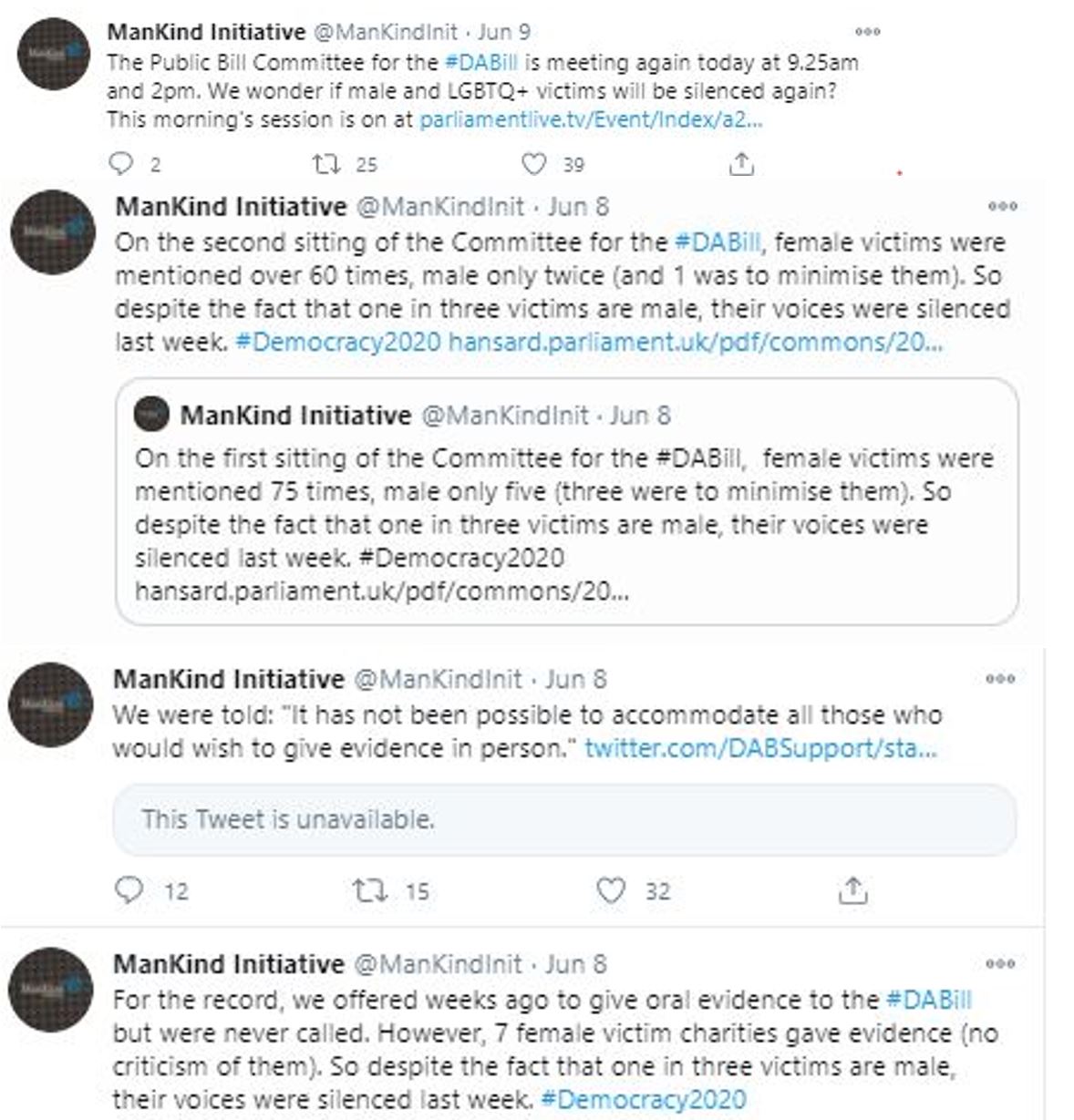
So despite the Duluth Model being discredited by its own author, subsequent studies showing it was ineffectual, and further studies showing that coercive and controlling behaviour is more prevalent among the female population, not only is our society failing to protect males from abuse or support them when they are subjected to it, but legislation is seeking to entrench in law those injustices, so that there will be no future hope, and so that the prevalence of domestic abuse against males continues to escalate, with further abuses against those victims perpetrated by the state who are very often supporting their abuser, on the basis of unsubstantiated claims made that they are the victim. And this leads me onto the subject of the Risk of Harms Review.
There are some 50k plus private family law cases each year, concerning where children will live post separation. Early in 2019, Women’s Aid (WA) intensified their lobbying of parliament to end the “presumption of contact” between parents and their children post separation, highlighting 4 cases over a 9-year period where children had been killed while on court ordered unsupervised contact with a non-resident father. This was off the back of a thoroughly dishonest report, published January 2016, named Nineteen Child Homicides[10], which to summarise, cherry picked 19 cases from 330, over a period of 20 years, where children had been killed by their fathers.
I say dishonest, because subsequent to the publication of this report, a rebuttal was written by The Empathy Gap, titled 330 Child Homicides[11], which looked at the data for all child homicides over the same period of time, and found that where child homicides were concerned, mothers were the greatest risk to children, a higher risk that biological and step fathers combined.
In any event, such was the intensity of lobbying from WA and related media hype, parliament ordered MoJ to assemble an expert panel, make a call for evidence and conduct a Risk of Harms Review. The exercise was intended to last 3 months, but took over 15 months to conclude, and the result was nothing short of a shambolic whitewash, I will explain why as concisely as possible.
Firstly, the MoJ quickly assembled an “expert panel” of 10, which consisted of 8 women and 2 men. Of the two men on the panel, one represented the MoJ (Lord Justice Cobb - even though MoJ were already represented by 3 females also assigned to the panel), the other was drawn from Respect, a charity providing intervention services for Male only perpetrators of domestic violence and with very close links to Women’s Aid. Aside from the 3 women from MoJ, there were two further female legal professionals, 2 more from Women’s Aid, and the final panellist was the chief social worker, also female. Whilst this alone is a striking imbalance, it is the absence of key stakeholders and relevant experts being appointed to the panel which is even more concerning. The missing stakeholders and experts included:
· Cafcass – the primary agency that works with families and children in family court proceedings, was excluded from the process entirely, with the resulting report largely scapegoating them for all of family courts problems, in effect Cafcass were put on trial in their absence and were not involved in any of the consultations, despite holding enormous and entirely relevant dataset and body of experience.
· Police – called upon for every case where there is a reported claim made of domestic abuse or violence, whether those claims are legitimate or “strategic”. It seems odd that they would have no relevance or valuable input to provide to this process.
· Male Domestic Abuse Charities – except for Respect, seemingly only appointed to provide views on perpetrators of domestic violence, there was no representation from any organisations that support male victims of domestic abuse or violence, such as Mankind Initiative. By contrast, Women’s Aid had not just one, but two representatives on the panel.
· Fathers Charity or Support Group – There was no representation at all on the panel for fathers, silencing the voice of half of all parents involved family law.
· Parental Alienation Charity or Support Groups – PA is arguably the most prevalent form of Domestic/Child abuse there is, yet it was wholly unrepresented on the panel, by any group or even individual expert.
· Child Psychology – No expert present to advise on child psychology and the impact on children of disruption to, or severance of, their parental and wider familial attachments.
· Female Domestic Abuse Perpetrators Expert – No representation or expertise in the area of female domestic abuse perpetration.
· Education – The impact of parental separation, domestic abuse and parental alienation can be severe, and the third parent is the teaching staff at school, where consequential learning and behavioural difficulties commonly arise, that can even impact the safety fellow pupils and staff, but no representation regardless.
· Adult behavioural psychologist – no expertise in this area, despite domestic abuse being driven significantly by mental health issues and drug/alcohol misuse.
· Mediation - No dispute resolution or mediation specialists, perhaps with data to share from all the failed or non-attended (by one side) mediation sessions.
By limiting panel representation to one for each area of expertise, rather than accommodating the double representation for Women’s Aid, quadruple representation for judiciary and double representation for the family law solicitors, the panel would have needed to grow from 10 to 15 seats, for all areas of relevance and expertise to be represented, which considering the level of importance of this exercise, seems perfectly reasonable to facilitate.
Aside from the makeup of the panel, the MoJ commissioned Dr Adrienne Barnett to provide them with a literature review document[12], with the intent of collating all the relevant scholarly articles and research into all the risk factors for the panel to digest and base their conclusions on. Dr Barnett is a self-identified radical feminist, former barrister, who has tweeted not only her views on fathers generally but also made it clear that she believes Parental Alienation is a con. Needless to say, the Duluth Model features heavily Dr Barnett’s literature review, as do circular references to her own prior research!

Conclusions from the already partisan panel, presented with a cherry-picked literature review, produced by a radical feminist denier of parental alienation, were provided to a group of 3 women commissioned to author the final report[13].
In August this year, the president of The Family Division of the MoJ, Sir Andrew McFarlane, was sent a Letter Before Claim[14], giving 30 days to respond to the identified reasons to challenge the panel process, its findings and its recommendations. The letter identifies more than 20 breaches of process or law, but no response was received. At the beginning of November 2020, a formal application was made for judicial review of the process, the remedy being that the report must be set aside, and the process rerun with a new panel, consisting all the relevant stakeholders and experts.
The review has recommended some sweeping changes, moving further towards the presumption of guilt up on allegation than ever before, dismissing Parental Alienation as nothing more than a tactic deployed by abusive fathers to continue the abuse of the mother, who is always the “protective parent”. A significant step is being taken to remove the ability of a parent accused of abuse to cross examine their accuser, and so in one fell swoop, making it substantially more difficult for a parent accused of sometimes very serious crimes, to challenge the claims that have been made.
Conclusion
Looking back at the growth of the domestic abuse charity sector, now funded to the tune of around £500m each year (to women’s services – but less than £2m for male services), I wonder how it is possible for there to continue to be an ever-escalating problem, while more and more services and funding are provided. Where are all these “abusers” going once they have had an order made against them, and been turfed out of their home, month on month and year on year. The more funding that Women’s Aid and Refuge receive, the more “abusers” there seem to be, yet if we take lockdown as a specific snapshot in time, it seems crazy that:
a) There are an ever-increasing number of (male) abusers in relationships, even though so many have been ousted in the years before (and so not exactly in a rush to repeat that mistake)
b) There are scant opportunities for socialising, or for new relationships to blossom in the workplace, so it doesn’t make sense that the same “abusers” are going from one relationship to the next and repeating their behaviour
It seems clear that the claim domestic abuse has been soaring during lockdown is at best substantially exaggerated and at worst merely a part of an opportunistic marketing tactic to wrestle funding from government to support women’s only domestic abuse services, and drive home amendments to the DA Bill that leave male victims of abuse wide open to further abuse and substantial increases in damage caused, with female perpetrators not only unable to receive rehabilitative therapy, but actively supported with the abuse of their partners and children, so long as they make a false claim to the police, a charity and the courts. It seems to me, that it is imperative for domestic abuse charities claims, regarding domestic abuse prevalence, be subjected to a thorough and independent investigation. Not only does it seem that they are materially misrepresenting the data to mislead the public, media and government, but the funding they are receiving is in large part being used to cause social problems and drive gender-based division through our society, causing extreme harm to innocent men and children.
[2] https://www.ucl.ac.uk/news/headlines/2020/may/recreational-drug-use-likely-diminish-during-covid-19-lockdown
[7] http://eprints.lse.ac.uk/105387/1/covid19_2020_06_30_home_is_not_a_safe_place_for_everyone_domestic.pdf
[12] https://assets.publishing.service.gov.uk/government/uploads/system/uploads/attachment_data/file/895175/domestic-abuse-private-law-children-cases-literature-review.pdf
